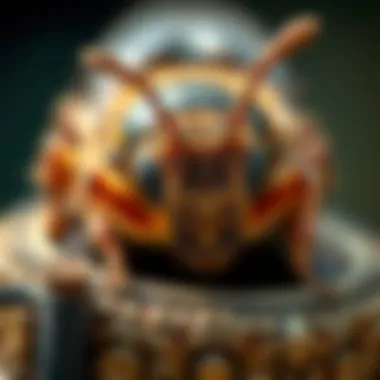Complete Guide to Pest Control in Spring Branch


Intro
Spring Branch, with its idyllic neighborhoods and picturesque landscapes, is not immune to the persistent challenge of pests. Homeowners and renters alike often face unwelcome guests, from ants marching in a line to the more elusive bed bugs that seem to appear out of nowhere. Understanding the local pest population is vital not only for maintaining a comfortable living environment but also for safeguarding the health of your family. This guide dives deep into the nitty-gritty of pest control, providing you with practical knowledge to tackle common pests effectively.
Whether you're a seasoned homeowner or a first-time renter, the emphasis on eco-friendly practices reflects the growing need for sustainable solutions. As we navigate through identification, prevention, and treatment options, it becomes clear that informed decisions can significantly contribute to a pest-free home. Let's begin our journey by identifying the common offenders that might be lurking in the corners of your property.
Identification of Common Pests
Recognizing which pests are invading your space is the first step in addressing the problem.
Description of Common Pests
In Spring Branch, a variety of pests make the list of most common intruders:
- Ants: These tiny nuisances often infiltrate homes searching for food. Different species, such as carpenter ants and fire ants, might have distinct behaviors.
- Cockroaches: Known for being hardy survivors, they prefer darkness and can multiply quickly if not dealt with promptly.
- Termites: Silent destroyers, they munch away at the wood in your home, potentially causing extensive damage.
- Mosquitoes: Breeding in stagnant water, they not only irritate with their bites but can also transmit diseases.
- Spiders: While many can help control other pests, their presence in large numbers can be unsettling.
Signs of Infestation
Identifying pests is not merely about spotting the critters. Many signs indicate a pest problem that may not be immediately visible:
- Droppings: Tiny droppings scattered near food sources can indicate the presence of rodents.
- Nest or Tunnel: Look for nests or tunnels within walls or basements, especially with termites or ants.
- Damage: Chew marks on food packaging or furniture can signal unwanted guests.
- Bites or Stings: Unexplained bites on family members could suggest a bed bug or mosquito problem.
Recognizing these signs early helps to nip any potential infestation in the bud.
Prevention Techniques
Preventing pests is recurrently easier than dealing with them after they’ve made themselves at home.
Home Maintenance Tips
- Seal Entries: Inspect doors and windows, ensuring there are no cracks or gaps that pests might exploit.
- Clean Regularly: Pests are often attracted to food scraps. A clean kitchen and dining area can deter many common pests.
- Reduce Clutter: Clutter provides hiding spots. Keeping spaces organized can make it tougher for pests to nest.
- Proper Waste Disposal: Always ensure bins are sealed and emptied regularly to avoid attracting pests.
Environmental Modifications
Making a few changes around your home can substantially decrease the chances of infestations:
- Proper Drainage: Ensure there are no pooling areas around your property where mosquitoes can breed.
- Trim and Prune: Keep plants well-maintained, trimming back branches that touch your roof or walls, as they can serve as bridges for pests.
- Mulching: If you mulch your garden, opt for materials that are less appealing to pests and provide barriers.
By combining regular maintenance with smart environmental choices, you place up numerous defenses against unwelcome critters.
Eco-Friendly Pest Control Options
For those conscious about the environment, relying on harsh chemicals isn't the only solution for pest problems.
Natural Pesticides
Using natural solutions can be effective while being kinder to the environment. Some examples include:
- Diatomaceous Earth: A powder made from fossilized algae, it can destroy the exoskeletons of insects like cockroaches and ants.
- Neem Oil: Derived from the seeds of the neem tree, it disrupts the life cycle of pests and deters many common insects.
- Essential Oils: Oils like peppermint or tea tree oil can repel certain pests when diluted and sprayed around the home.
Organic Pest Control Techniques
Adopting organic methods can significantly reduce pest populations:
- Traps: Sticky traps or bait traps for pests like insects can reduce their numbers without chemicals.
- Companion Planting: Planting marigolds or citronella near vulnerable areas can naturally repel ants and mosquitoes.
- Encouraging Beneficial Insects: Ladybugs and lacewings can help control aphid populations without chemical intervention.
Overview of Pest Control in Spring Branch
Pest control in Spring Branch is more than just a seasonal chore; it’s a fundamental aspect of maintaining a healthy environment for homes and communities. With the unique climate and ecosystem of the area, the pest landscape can shift dramatically throughout the year. Thus, understanding this topic carries significant weight, not only in terms of comfort but also health and safety for residents.
When it comes to pests, whether it’s a pesky ant invasion or a more severe rodent issue, knowledge is power. Describing the local challenges helps homeowners better prepare and respond effectively. Certain pests are notorious in Spring Branch, drawing on the warm weather and abundant resources. Recognizing these trends equips residents with valuable insights, making it easier to identify and confront issues before they escalate.
Understanding Local Pest Challenges
Every region brings along its own set of pest-related challenges, and Spring Branch is no different. The warm climate welcomes a variety of pests throughout the year. Mice scurrying around, ants forming organized lines, and even the occasional cockroach can be quite common. Each of these pests have different behaviors and preferences when it comes to nesting and feeding, making it essential for residents to become attuned to the local pest dynamics.
Moreover, with seasonal changes, it's not uncommon to see an uptick in certain pest populations in specific months. For instance, as spring rolls around, ants typically emerge in droves, motivated by warmer temperatures and the promise of food sources lying around. People often overlook these seasonal shifts until they find themselves knee-deep in a pest dilemma. This is why seasonal awareness is crucial, as it can save a lot of pain later down the line.
Importance of Pest Control for Community Health
Pest control is not solely about safeguarding your property; it also plays a vital role in the overall health of the community. Unchecked pest populations can lead to serious health issues, ranging from allergies triggered by insects to more severe concerns like the transmission of diseases. Rodents are notorious for spreading illnesses, which can have serious repercussions for residents.
"An ounce of prevention is worth a pound of cure."
Finding a balance between effective pest management and environmental responsibility is key. Regular pest control measures help keep populations in check and ward off diseases, thereby allowing families to enjoy their spaces without fear. By addressing pest issues promptly, communities foster a healthier living environment, ultimately impacting everyone's well-being.
Identifying Common Pests in Spring Branch
Understanding pest identification is crucial for effective pest management in any environment, but especially in Spring Branch. This area, with its unique climate and ecological characteristics, harbors specific pests that can cause significant issues for homeowners. Recognizing these pests helps in implementing appropriate control measures, ensuring a healthy living space and protecting property investments.
Rodents: Mice and Rats


Rodents like mice and rats are some of the most common pests in Spring Branch. They’re sneaky critters that can slip into your home through the tiniest cracks or openings. Mice multiply rapidly; just a few breeding pairs can turn into a full-blown infestation if not managed early.
One key benefit of identifying these rodents early is the prevention of damage. Mice and rats can gnaw through electrical wires, insulation, and even wooden structures. Moreover, they can carry diseases, posing health risks to residents. Surveys show mice can lead to allergic reactions or even spread serious illnesses. Keep an eye out for droppings in cabinets or along baseboards, as this is often the first indicator that you may have a visitor.
Insects: Ants and Cockroaches
Insects such as ants and cockroaches are nuisances that, once established, can be difficult to eliminate. Ants, especially, can march in single file, hunting for food sources in kitchens and pantries. Identify species like the carpenter ant, which can damage wooden structures, or the fire ant, known for its aggressive sting. It’s important to determine the species in order to select the right control method.
Cockroaches, on the other hand, are notorious for their resilience. They thrive in damp areas, such as basements or behind appliances. Their droppings can be a sign of an infestation and are not just unpleasant but also harmful, containing allergens that could exacerbate respiratory issues. Keeping a clean environment and sealing food containers is crucial in prevention.
Termites: The Silent Destroyers
Termites are often referred to as silent destroyers for a good reason. By the time signs of their presence are visible, significant damage may have already occurred. They feast on cellulose, found in wood and paper products. If you discover mud tubes along foundations or damaged wood that sounds hollow when tapped, it’s crucial to act promptly. One reason pest identification is vital is that termite damage can drastically affect property value and could even lead to costly repairs if left unchecked.
Regular inspections and monitoring can help mitigate these risks, along with setting bait systems that identify their activity before they can cause harm.
Seasonal Pest Variations
Pest populations can fluctuate with the seasons in Spring Branch, making it essential to adapt control strategies accordingly. In the spring, as temperatures rise, many pests start their life cycles. This is when you might see an influx of ants and other insects coming out for food or nesting.
During summer, conditions can become favorable for rodent activity as they seek moisture and food. Conversely, certain pests like that pesky mosquito can peak during this time, making outdoor activities less enjoyable.
As autumn rolls around, rodents might make their move indoors to find warmth, while some insects seek shelter for hibernation. Understanding these seasonal patterns aids in preparing your home to deter unwelcome visitors before they have a chance to set up shop.
"The best offense is a good defense." Keeping track of pests through their seasonal variations can save you future headaches.
Overall, being vigilant about pest identification is the first line of defense against infestations. The sooner you can identify and act on any potential issues, the better your chances of maintaining a pest-free environment.
Understanding Pest Behavior
Understanding pest behavior is essential in effectively managing pest populations, particularly in a region like Spring Branch, where diverse ecosystems exist. Knowledge of how pests behave not only aids in identifying infestations early but also enhances the effectiveness of prevention strategies. By recognizing the habits, life cycles, and environmental preferences of pests, homeowners can implement targeted approaches, ultimately steering clear of common pitfalls associated with traditional pest management methods.
Frequent pest problems can stem from a lack of insight into these behaviors. Homeowners often find that mere eradication isn't enough; understanding the reasons behind pest surges allows for deeper, more sustainable solutions. Therefore, those looking to safeguard their homes must prioritize the study of these creatures to minimize future occurrences.
Life Cycle of Common Pests
The life cycle of pests can vary dramatically between species, but most undergo several stages before reaching maturity. For instance, the common housefly moves through egg, larva (or maggot), pupa, and adult stages, with each phase requiring tailored control measures. On the other hand, rodents like rats grow quickly from pup to breeding adult in just a few weeks. Knowing whether a pest reproduces rapidly or requires a more extended period to blossom can influence your control strategy.
An effective way to visualize these stages is:
- Egg: Invisible to the naked eye, eggs are often placed in warm and concealed locations.
- Larva/Nymph: This stage often sees the pest feeding voraciously, leading to noticeable infestations.
- Pupa: Here they develop before maturing, which can be a crucial point for intervention.
- Adult: The final stage, typically when reproduction occurs.
Understanding this cycle empowers homeowners to strike at the most vulnerable points in a pest's life, thus curbing their population more effectively.
Feeding Habits and Preferences
Different pests have distinctive diets that dictate their feeding habits and preferences. Understanding what draws them to your property plays a pivotal role in pest control.
- Rats and Mice: These rodents favor grains, fruits, and seeds but won't hesitate to nibble on almost anything when in need.
- Cockroaches: Omnivorous in nature, they thrive on starches and sugars, often discovered in kitchens and pantries.
- Termites: Being wood eaters, they prefer cellulose materials which can be found in homes, making them particularly destructive.
Recognizing these eating patterns allows homeowners to make informed decisions regarding food storage and waste management. Simple shifts, like sealing food tightly and cleaning messes promptly, can significantly deter unwelcome visitors from making themselves at home.
Mating Patterns and Population Growth
Pests reproduce at alarming rates, and understanding their mating behaviors can drastically alter your control plan. For example, female cockroaches can lay hundreds of eggs throughout their lifetime, significantly escalating their presence within months. Similarly, rodents are known for breeding various times per year, resulting in populations ballooning if left unchecked.
- Courtship Routines: Many species engage in elaborate mating rituals, which can be a window of opportunity for pest management interventions.
- Nesting Habits: Identifying breeding nests is crucial in eliminating future populations, addressing not just adults but also their offspring before they can proliferate.
Being proactive in identifying these patterns gives homeowners a leg up, preventing infestations before they start.
In summary, understanding the behaviors of common pests not only illuminates the complexities surrounding infestations but also enhances the efficacy of control measures. This knowledge serves as a cornerstone for establishing a long-term pest management strategy, fostering a pest-free environment in Spring Branch.
Prevention Strategies
Preventing infestations in Spring Branch is both an art and a science. Effective pest prevention goes beyond merely reacting to problems when they arise. Instead, it encompasses proactive measures that ensure your home and property remain free from pests. By focusing on prevention strategies, homeowners can save time, money, and frustration down the line. These strategies are pivotal for maintaining a healthy environment, offering benefits like decreased reliance on harmful chemicals and fostering community well-being.
Maintaining Property Integrity
The first line of defense against pests starts with how well your property is maintained. A well-kept property not only enhances its aesthetic appeal but also minimizes potential pest habitats. Here’s what to consider:
- Seal Cracks and Openings: Regularly inspect foundations, windows, and doors for gaps. Sealing these not only keeps pests out but also protects against moisture damage, which can cause further problems.
- Roof and Gutter Care: Clogged gutters can lead to stagnant water, creating a breeding ground for mosquitoes and other pests. Clean your gutters regularly, and make sure your roof is in good shape.
- Proper Ventilation: Ensuring good airflow in attics and basements reduces humidity, which deters pests that thrive in damp environments.
By paying attention to these elements, a homeowner can significantly reduce the risk of infestations.
Proper Waste Management
Keeping your property trash-free is crucial in deterring pests. Improperly managed waste attracts rodents, insects, and other pests, so proper waste management is a key strategy in prevention. Here are some practical tips:
- Secure Garbage Bins: Ensure all waste containers have tight-fitting lids. This prevents odors from escaping and pests from being attracted to the food remnants inside.
- Compost Carefully: If you compost, be mindful of what you add. Avoid composting meat and dairy, as these can attract unwanted critters.
- Regular Disposal Schedule: Create a schedule to dispose of waste regularly. Leaving trash for extended periods encourages pests to take up residence.
"An ounce of prevention is worth a pound of cure." Regularly managing waste can keep pest troubles at bay and maintain a clean environment.


Landscaping Tips to Deter Pests
Landscaping can also play a significant role in pest prevention. The way you design and maintain your outdoor spaces can dissuade various pests from advancing into your home. Consider these strategies:
- Choose the Right Plants: Some plants naturally repel pests. For instance, marigolds are famous for warding off nematodes, while lavender and mint can deter ants and mosquitoes.
- Maintain Distance: Keep mulch, wood piles, and shrubs at least a foot away from your foundation. This discourages pests from nesting too close to your home.
- Water Wisely: Avoid overwatering plants; standing water is an open invitation for mosquitoes and other pests. Use soaker hoses or drip irrigation to keep moisture around your plants without saturating the soil.
Implementing these landscaping tips will not only beautify your yard but will be a crucial part of your pest control strategy.
Eco-Friendly Pest Control Methods
In an age where environmental awareness is at an all-time high, the demand for eco-friendly pest control methods has gained momentum. This section delves into the significance of adopting sustainable practices in managing pest problems. Households in Spring Branch can benefit immensely from these methods by reducing their carbon footprint while ensuring a pest-free environment. Implementing eco-friendly strategies not only supports community health, it promotes biodiversity and enhances the quality of living spaces.
By prioritizing the well-being of the environment, homeowners also show their commitment to safeguarding nature. Natural solutions and sustainable practices can often be as effective as conventional methods, if not more so. Therefore, understanding eco-friendly pest control is not merely a trend but a vital component of responsible living in any community focused on health.
Organic Pesticides: Natural Solutions
Organic pesticides offer robust alternatives to synthetic chemicals, preserving both human health and the surrounding ecosystem. Made from natural ingredients, these pesticides tend to break down more quickly in the environment, minimizing harmful residues. Common organic options include Neem oil, diatomaceous earth, and insecticidal soap. Each of these provides effective control while being easier on the planet.
Furthermore, organic solutions are remarkably versatile. They can be used both indoors and outdoors without posing significant risks to pets, children, or beneficial insects, such as pollinators. For instance, Neem oil, derived from the seeds of the neem tree, works by disrupting the life cycle of pests like aphids and spider mites. Diatomaceous earth, a powder made from fossilized algae, physically damages insect exoskeletons when they come into contact with it.
"The best pesticide is a healthy ecosystem."
– Anonymous
Cultural Control Practices
Cultural control practices involve modifying farming or gardening techniques to minimize pest infestations. Strategies include crop rotation, maintaining proper sanitation, and selecting pest-resistant plant varieties. In Spring Branch, homeowners can implement these practices easily. For instance, by rotating the types of plants each season, pests that thrive in specific conditions can be disrupted in their life cycles, reducing their numbers over time.
Proper sanitation is also paramount. Ensuring that organic waste is disposed of correctly can limit habitat opportunities for pests. Regularly cleaning outdoor areas, like gardens or patios, to remove debris or old plant matter is essential. Another interesting aspect is choosing native plants for landscaping. These plants often require less maintenance and are more resistant to local pests, thus naturally reducing the need for chemical intervention.
Biological Control: Beneficial Organisms
Biological control utilizes beneficial organisms to manage pest populations naturally. This method strengthens the ecosystem, rather than disrupting it. For instance, ladybugs and lacewings are invaluable allies; they consume pests like aphids and caterpillars. By encouraging these predatory insects, homeowners in Spring Branch can establish a natural balance.
Furthermore, introducing nematodes can effectively control soil-dwelling pests. These microscopic worms can be applied to gardens where they will seek out harmful insects, such as grubs, providing an effective biological solution without harmful chemicals.
Incorporating these practices not only helps reduce pest pressure but promotes biodiversity, which is crucial for thriving ecosystems. By engaging in these approaches, households contribute to a healthier planet while safeguarding their own living spaces from pests.
For additional insights into organic and sustainable pest management techniques, consider visiting USDA.gov or EPA.gov.
All these eco-friendly methods highlight the power of responsibility we have as individuals to work in harmony with nature while effectively controlling pests.
Chemical Pest Management
Chemical pest management is a fundamental strategy in maintaining pest-free environments. It revolves around the use of chemical substances to eliminate unwanted pests, providing a swift solution to infestations that can escalate if left unchecked. Homeowners in Spring Branch often find themselves at a crossroads when it comes to tackling pest challenges; that’s where chemical pest management comes into play. The effectiveness of these treatments can be palpable, restoring peace and comfort in homes where pests once reigned.
Types of Chemical Treatments
Understanding the types of chemical treatments available is essential for anyone looking to manage pest populations effectively. Here’s a rundown of the most common categories:
- Insecticides: Designed to target pests like ants, roaches, and flies. These can be further categorized into contact poisons, which kill pests on contact, and stomach poisons, which damage the pest upon ingestion.
- Rodenticides: Specifically formulated to deal with rodent infestations—like those pesky rats and mice. These substances can be highly toxic, and it's crucial to avoid exposure to other wildlife.
- Herbicides: While primarily used for plant pests, herbicides can play a role in pest management. Weeds can harbor insects and serve as breeding grounds for various pests, making these treatments part of an integrated pest management approach.
- Fungicides: Though more related to plants and fungi, controlling the growth of certain fungi can prevent pest-related issues that arise from mold and dampness in home environments.
- Acaricides: These are specifically targeted towards arachnids, including ticks and mites, which can pose health risks to both humans and pets.
Chemical treatments, however, must be strategically selected and applied to ensure effectiveness while minimizing harm to the surrounding environment.
Safety Considerations for Homeowners
When it comes to chemical pest management, safety cannot be overlooked. Here are a few key considerations that homeowners should bear in mind:
- Read Labels Carefully: Each product comes with specific instructions and safety guidelines. Understanding these directions is non-negotiable. Ignoring them can lead to unintended harm.
- Protective Gear: Using gloves, masks, and goggles while applying chemical treatments can provide a layer of protection from fumes or contact with the skin.
- Ventilation is Key: Ensure that the area being treated is well-ventilated. This helps reduce inhalation of harmful chemicals during and after application.
- Follow Application Guidelines: Adhering to the recommended dosages and intervals between applications is crucial for safety and effectiveness. More is not always better—overapplication can lead to chemical resistance in pests.
- Keep Pets and Children Away: Until the area has been treated and safely ventilated, it’s essential to keep pets and children at a safe distance to prevent accidental exposure.
"Safety first: Chemical pest management must prioritize the well-being of your family and pets."
By understanding these safety protocols, homeowners can implement chemical pest management practices that are effective yet responsible.
For more insights about pest control methods, you might find it helpful to check resources from EPA or CDC which provide further information on safe pest control practices.
Implementing Integrated Pest Management
Integrated Pest Management (IPM) is a strategic approach to pest control that merges various methods to manage pest populations effectively while posing minimal risks to people, property, and the environment. The importance of implementing IPM in Spring Branch cannot be overstated, especially considering the distinct challenges posed by local pests. This holistic methodology goes beyond traditional pest control practices by fostering a deeper understanding of pest behavior, integrating preventative measures, and utilizing targeted control techniques. The ultimate aim is not just to eliminate pests but to manage them in a sustainable manner, ensuring long-term effectiveness and safety.
A pivotal element of IPM is its multifaceted nature, which may involve monitoring pest populations, identifying pest species, and analyzing the risk factors that contribute to infestations. Homeowners can therefore make informed decisions about whether to take action or simply adjust their practices to deter pests. This foresight is particularly beneficial in a community-focused setting where pest management does not just protect individual homes but contributes to the health and well-being of the entire neighborhood.
Here are a few key benefits of implementing IPM:
- Eco-Friendly: By prioritizing natural controls and limiting chemical treatments, IPM aligns well with contemporary environmental standards.
- Cost-Effective: Fewer pesticide applications can lead to savings in the long run, reducing expenses associated with frequent treatments.
- Healthier Homes: This method minimizes the risk of pesticide exposure for families and pets, creating a safer living environment.
Overall, the incorporation of IPM into pest management strategies in Spring Branch enhances community health and drives a proactive approach toward pest challenges.
Principles of IPM
The foundation of IPM rests upon several core principles that guide its implementation. These principles help define the strategies employed and ensure they are effective while also being sustainable.
- Prevention: Preventive measures are the first line of defense. This includes maintaining good sanitation, sealing entry points, and managing landscaping to deter pests.
- Monitoring: Regular inspection of properties to identify the presence of pests is crucial. By keeping an eye on pest populations, homeowners can accurately assess when intervention is necessary.
- Identification: Properly identifying pests allows for the selection of the most effective management techniques. Misidentifying a pest can lead to ineffective treatments and wasted resources.
- Control Methods: IPM employs a mix of cultural, mechanical, biological, and chemical tactics. For example, using natural predators to control common pests alongside targeted pesticide application can significantly reduce pest populations without overwhelming the environment.
- Assessment: After implementing control measures, it’s essential to evaluate their effectiveness and make adjustments if necessary. This cyclical process ensures continuous improvement in pest management practices.


By embracing these principles, homeowners in Spring Branch can cultivate an effective IPM strategy tailored to their unique pest challenges.
Monitoring and Evaluation Techniques
Monitoring and evaluation are the backbone of successful IPM implementation. Without accurate data, it becomes challenging to make informed decisions regarding pest management.
- Regular Inspections: Homeowners should conduct routine inspections around their properties. Checking for droppings, nests, and general signs of pest activity can provide early warnings.
- Pest Traps: Utilizing traps can help monitor pest populations and species presence. For instance, sticky traps for insects can indicate the levels of specific pest populations over time.
- Record Keeping: Maintaining detailed logs of pest encounters, treatments applied, and their outcomes aids in recognizing patterns. Over time, this information can inform future pest management strategies.
- Threshold Levels: Establishing action thresholds for pest populations is critical. These levels indicate when a pest presence necessitates intervention. Understanding these thresholds can aid homeowners in being proactive rather than reactive.
- Feedback Loop: Evaluation of control protocols should take place after pest management interventions. Were the methods effective? Do adjustments need to be made? This loop encourages continuous refinement of pest control strategies.
Ultimately, effective monitoring and evaluation techniques empower homeowners to stay ahead of potential pest issues, making IPM a dynamic and responsive approach to pest management.
Professional Pest Control Services
In the realm of pest control, the value of seeking professional assistance cannot be overstated. While DIY methods may seem tempting for many homeowners, challenges can often arise that require specialized skill sets and knowledge. Professional pest control services provide a comprehensive approach to managing infestations and maintaining a peaceful living environment in Spring Branch.
When to Consider Professional Help
Sometimes, despite our best efforts, pests can outsmart our defenses. If you find yourself facing ongoing issues with pests that don’t seem to budge, it might be time to give a professional a ring. There are several indications that you should reach out for expert assistance:
- Severe Infestation: If you notice an alarming number of rodents or insects scurrying about, it’s a sign that your home needs thorough attention.
- Health Risks: Some pests carry disease, like rodents or cockroaches. If you’re concerned about potential health risks to your family or pets, don’t hesitate to get help.
- Persistent Problems: If you’ve made attempts at prevention—sealing cracks or using traps, but the pests keep returning, it’s time to call in the pros.
- Time Constraints: Often busy lifestyles don’t allow us the time to deal with pest issues effectively. Professionals can quickly assess and address the situation without putting a strain on your schedule.
When deciding to entertain the idea of professional help, the first step is to weigh these factors carefully. A timely intervention can prevent much bigger headaches down the road.
Choosing the Right Pest Control Company
Selecting the right pest control company requires careful consideration. It’s not just a simple matter of calling the first name that pops up in a search. You need to ensure that the service provider you choose meets certain standards. Here are the key points to ponder:
- Research and Reviews: Look for companies that have solid reputations, backed by good reviews from previous clients. Websites like Yelp and the Better Business Bureau can provide insight.
- Certification and Licensing: Always check if the company is licensed to operate in your area. In Spring Branch, proper certifications mean the company adheres to state and local regulations, which is essential for safety and effectiveness.
- Experience with Specific Pests: Some companies specialize in particular types of pests, such as bedbugs or termites. Ensure that the company you’re considering is experienced in handling the specific pest issue you’re facing.
- Eco-Friendly Practices: In today’s world, it’s also important to consider how the company approaches pest control. Ask about their methods— are they using safe, eco-friendly products?
- Transparent Pricing: Understand the costs upfront, including any additional fees for follow-up visits. A reputable company will provide a clear breakdown of their services and costs.
In summary, investing the time to choose the right pest control company can lead to a more effective resolution of your pest issues. Remember, a stitch in time saves nine – tackling the problem early can save you from larger headaches later.
"An ounce of prevention is worth a pound of cure." – Benjamin Franklin
For further reading, consider checking resources on pest management strategies at National Pest Management Association and relevant local guidelines on pest control at Texas Department of Agriculture.
By carefully selecting the right professionals, you're not only ensuring immediate solutions but also a sustainable approach to pest management in your home.
Regulations and Compliance in Pest Control
In every community, pest control laws and regulations play a vital role in ensuring public health and safety. In Spring Branch, these regulations not only protect the environment but also provide a framework for responsible pest management practices. Having a clear understanding of the regulations helps homeowners and pest control professionals navigate the complexities involved in maintaining a pest-free living space while ensuring that the application of pesticides and other methods comply with local standards.
State and Local Regulations
State and local regulations govern a wide array of pest control practices. In Texas, the Department of Agriculture oversees pest management and regulates the use of pesticides. Each municipality, including Spring Branch, may have additional rules specific to their environments.
Some key points regarding state and local regulations include:
- Certification Requirements: Pest control professionals must often obtain certifications or licenses to apply specific chemicals. This guarantees that they are educated about proper application and safety protocols.
- Reporting Regulations: Certain pests and infestations must be reported to local authorities, especially when they affect food sources or public health. This is particularly relevant for agricultural properties in the area.
- Environmental Protection: Laws often emphasize minimizing the impact of pest control practices on the surrounding ecosystem. For instance, precise application techniques may be mandated to avoid runoff that could harm waterways.
The strict compliance with these regulations fosters a sense of community trust, ensuring neighbors feel safe from unchecked pest activity. If you’re in doubt, always check with the Texas Department of Agriculture or local authorities before taking pest management actions.
Pesticide Use and Restrictions
When it comes to pesticides, there are specific restrictions that must be adhered to at all times. Understanding these restrictions is crucial for homeowners looking to tackle pest problems efficiently but safely.
Consider the following factors when using pesticides:
- Labeling and Use Instructions: It’s crucial to always read pesticide labels. They provide essential information, including application rates and safety precautions. Using pesticides contrary to label instructions can lead to legal liabilities and environmental harm.
- Restricted Use Products: Some pesticides are deemed restricted use and need special permits for application. For instance, if a product is toxic to pollinators, its use may be strictly limited during certain times.
- Rescue Operations: In emergency situations, such as dealing with an infestation that poses an immediate risk to health, there are protocols in place for expedited pesticide use. However, even in emergencies, adherence to local regulations is mandatory.
Homeowners should also remain mindful of any seasonal restrictions, as certain treatments may not be permitted during specific times of the year to protect crops or hazardous areas.
Strict adherence to regulations not only protects individual health but also sustains the ecosystem, fostering a balanced cohabitation of humans and nature.
Future Trends in Pest Management
As the world continues to evolve, so does the approach to pest management. In Spring Branch, understanding these trends is essential for homeowners and renters alike. The way pests are controlled is shifting from traditional methods toward more innovative and sustainable practices. Emphasizing technology and eco-friendliness not only ensures effective pest control but also contributes positively to the environment. Keeping an eye on these trends is vital for both immediate and long-term pest management success.
Technological Innovations
In recent years, the pest control industry has experienced significant advancements in technology. Smart devices, Artificial Intelligence (AI), and data analytics have started to revolutionize how pest management is executed. For instance, the use of integrated pest management (IPM) apps can help homeowners pinpoint pest issues clearly and swiftly. These apps often include features for identifying pests through image recognition, which makes it easier for users to understand what they're dealing with.
Additionally, innovations like ultrasonic pest repellents are gaining traction. These devices use high-frequency sound waves to deter pests without using any chemicals, making them safer for households with children or pets. Another great tech development is drones, which can survey large properties to identify nests or infestations that would otherwise be hard to reach.
Homeowners can also benefit from monitoring systems that alert them to potential pest problems before they escalate. Overall, technological advancements not only improve the speed and efficacy of pest detection but also reduce the need for harmful chemicals, leading to safer households.
Sustainability in Pest Control
Sustainability is not just a trend; it's a necessity in today's world. The pest control industry is beginning to embrace eco-friendly methods that align with broader environmental goals. Homeowners are increasingly looking for ways to manage pests while minimizing harm to their surroundings.
One common practice involves the use of organic pesticides made from natural ingredients. These products can be just as effective as their chemical counterparts but carry significantly fewer risks for both humans and the ecosystem. For example, neem oil, derived from the seeds of the neem tree, is known for its effectiveness against various pests while being safe for beneficial insects like bees and ladybugs.
Another sustainable approach is cultural pest management, which involves modifying practices to reduce pest habitats. This includes planting pest-resistant varieties, maintaining proper drainage to avoid standing water, and integrating wildlife-friendly practices that attract natural predators to pest populations.
"Sustainable pest control is not a one-size-fits-all solution; it's a tailored approach that considers specific environmental factors and pest behaviors."
Moreover, educating the community about the importance of biodiversity can play a crucial role in pest management. By fostering a balance in local ecosystems, pests can be naturally kept in check. This holistic perspective is not only effective in pest control but also contributes positively to the community's health and well-being.
In summary, the future of pest management lies in marrying technology with sustainable practices. By staying informed about these trends, homeowners in Spring Branch can adopt methods that not only manage pests effectively but also protect the environment for future generations. It is an ongoing journey, but one that promises to yield beneficial results for all.







